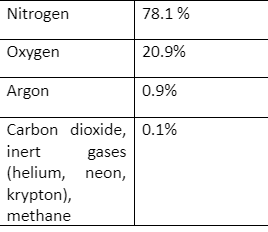Earth is the composition of certain elements which undergo specific chemical reactions due to variations in temperature, pressure, and altitude. According to the studies, the earth comprises five layers that attain various atmospheric conditions, weather, temperature, air pressure, and chemical elements. Despite these layers of the atmosphere, as per certain ancestral studies, the four significant elements that complete earth are air, water, fire, and earth. Research and studies state that air pressure on each layer of earth impacts the air pressure. Higher is the altitude; pressure is its reciprocal, i.e., low.
What Is The Atmosphere?
The definition of the atmosphere is the mixture of gaseous elements around the planetary system. The atmosphere and associated conditions around the earth make the existence of life possible on earth. The layers of the atmosphere around earth consist of specific chemical elements like ozone, hydrogen, and helium, which maintain the temperature and weather. These elements prevent the earth from harmful ultraviolet rays and x-rays emitted by the sun. The atmospheric layers empower the balance in temperature and climatic conditions on the earth. The primary atmospheric layers present on the surface of the earth are
- Troposphere (0-13 km)
- Stratosphere (13-25 km)
- Mesosphere (25-50 km)
- Thermosphere (50-75 km)
- Exosphere (75-150 km)
Composition Of The Earth
As per the studies, the composition of the atmosphere of earth comprises of five layers termed as Troposphere, stratosphere, mesosphere, thermosphere, and exosphere. Atmospheric layers of earth are spread around 10,000 km over the earth’s surface area. Discussing the chemical element’s oxygen is the most crucial element present on earth and the only reason for the presence of life. Below is the tabular description of all the chemical elements which form the composition of the earth:

Impact Of Variation In Air Pressure According To The Altitude
Altitude refers to the distance of a particular location above sea level according to the different layers of the atmosphere. There is a frequent decrease in the oxygen level at high altitudes, which often result in severe health conditions for human beings.
The atmospheric regions above sea levels are termed as high-altitude and low altitude. As per the altitude, the air pressure and temperature variations in the atmospheric condition of the earth. Therefore, the measurement of altitude is directly related to air pressure which is often measured by an altimeter and is termed as indicated altitude.
Below is some factual information that relates to the rise in altitude according to the air pressure and layers of the atmosphere:
- According to the definition of atmosphere, if there is a rise in the altitudes, there is a simultaneous decrease in air pressure. The mountaineers need supportive oxygen cylinders for the peak mountains, generally for 8000 feet above sea level.
- There are two main reasons for the low air pressure on high altitudes, Gravity and density. Gravity power on earth is relatively high and decreases with the simultaneous increase in altitude. Hence gravitational power pulls the air close to the surface of the earth.
- Density is the second factor for the low air pressure on high altitudes. When the altitude is increased, the gaseous molecules present in the air decrease. It results in the low density of air in the high altitudes compared to the sir density near the sea level.
- The temperature in high altitudes is less than the temperature near the sea level as per the composition of the atmosphere. It makes the weather condition on the high altitude colder as per the temperature condition near the sea level. This variation is due to low air pressure and air expansion, where the dispersion of gaseous molecules like oxygen, nitrogen, and carbon dioxide. There are very few chances of collision in these gaseous molecules.
- The human body reacts in a specific manner in high altitudes. In the high altitudes and states of low air pressure, a meagre amount of oxygen is available for breathing. People often suffer shortness of breath and altitude sickness in high regions.
- Variable regions attain different air pressure, directly impacting climatic conditions and humidity. Air pressure is also low on the location near the poles.
Conclusion
It is the study of the layers of the atmosphere and information regarding the composition of the earth. The earth comprises various chemical elements that involve particular chemical reactions due to changes in atmospheric temperature and process and vice versa. On the high altitudes, variations in temperature and pressure are experienced with changes in climatic conditions and surroundings. Factors like density and Gravity impact the air pressure variation on the high level of altitudes. The altitudes are measured according to the location’s distance from the sea level.
 Profile
Profile Settings
Settings Refer your friends
Refer your friends Sign out
Sign out




